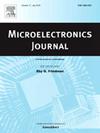High-selectivity fully tunable wideband bandpass filter with adaptive transmission zeros
IF 1.9
3区 工程技术
Q3 ENGINEERING, ELECTRICAL & ELECTRONIC
引用次数: 0
Abstract
This paper presents a compact fully tunable wide-band bandpass filter based on the varactors loaded quadruple mode coupled resonator. Triple adaptive transmission zeros (TZs) have achieved by reasonably setting the identical shifting mechanism architecture of transmission poles and adjacent TZs, which dramatically improve the selectivity. Meanwhile, it realized the tunable center frequency (CF) with a constant absolute bandwidth, resulting in the CF tuning range of 26.7 %, 25.8 %, and 15.6 % from 1.5 to 1.95 GHz. The bandwidth tuning range of 42.7 % can be achieved from 180 to 920 MHz with a fixed CF. The test results match well with the theoretical simulation so as to successfully validate the correctness of the proposed design approach.
求助全文
约1分钟内获得全文
求助全文
来源期刊

Microelectronics Journal
工程技术-工程:电子与电气
CiteScore
4.00
自引率
27.30%
发文量
222
审稿时长
43 days
期刊介绍:
Published since 1969, the Microelectronics Journal is an international forum for the dissemination of research and applications of microelectronic systems, circuits, and emerging technologies. Papers published in the Microelectronics Journal have undergone peer review to ensure originality, relevance, and timeliness. The journal thus provides a worldwide, regular, and comprehensive update on microelectronic circuits and systems.
The Microelectronics Journal invites papers describing significant research and applications in all of the areas listed below. Comprehensive review/survey papers covering recent developments will also be considered. The Microelectronics Journal covers circuits and systems. This topic includes but is not limited to: Analog, digital, mixed, and RF circuits and related design methodologies; Logic, architectural, and system level synthesis; Testing, design for testability, built-in self-test; Area, power, and thermal analysis and design; Mixed-domain simulation and design; Embedded systems; Non-von Neumann computing and related technologies and circuits; Design and test of high complexity systems integration; SoC, NoC, SIP, and NIP design and test; 3-D integration design and analysis; Emerging device technologies and circuits, such as FinFETs, SETs, spintronics, SFQ, MTJ, etc.
Application aspects such as signal and image processing including circuits for cryptography, sensors, and actuators including sensor networks, reliability and quality issues, and economic models are also welcome.
 求助内容:
求助内容: 应助结果提醒方式:
应助结果提醒方式:


